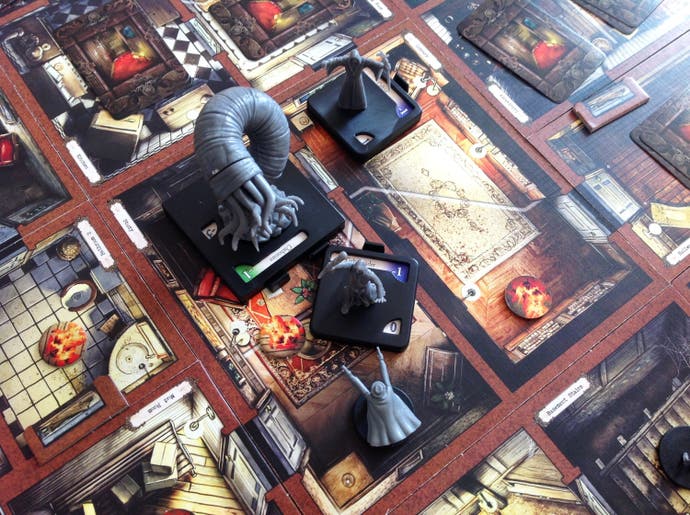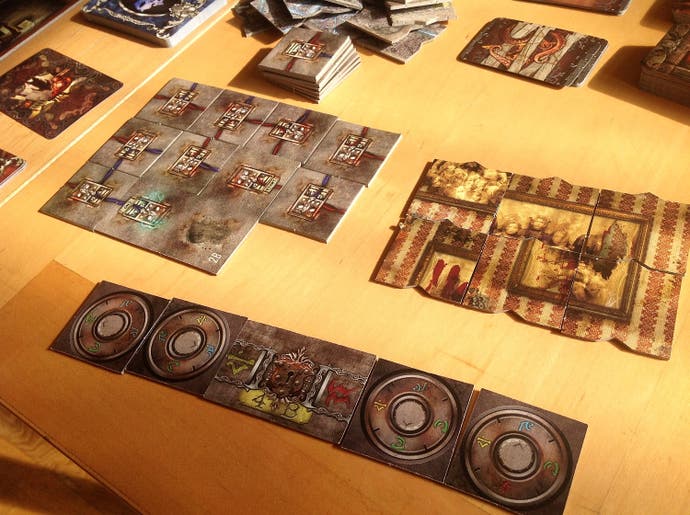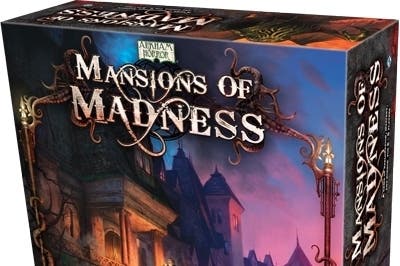Mansions of Madness review
Love craft?

Price: £55 / Players: 2-5 / Time: 3 hours
So far, Eurogamer's board game reviews have focused on out-and-out recommendations. Now, take my hand. Let me take you somewhere a little more interesting - and a lot darker.
Mansions of Madness came out in 2011, riding a raft of portentous marketing from Fantasy Flight. Here was a game of H.P. Lovecraft's fiction, his nauseating realm of Cthulu and alien hounds with the power to move between corners - any corners - and it was as mad and untamed as any Lovecraft story.
Arguably, the game would have made an even bigger splash if you'd thrown it in a river. While Mansions of Madness is more than a little awkward, the box is absolutely huge.
One to four players control "Investigators" arriving on the scene of some ominous mystery. The board is a 1930s house made from gorgeous interlocking tiles. Their objective is to put a stop to whatever horror is inevitably occurring within: anything from a ghost, to witches, to cultists trying to lure some elder god into our fragile reality.
The Investigators do this with brains and teamwork. This isn't, however, some gore-flecked Cluedo. The Investigators will be halting evil with guns, dynamite, or even their bare hands. Mansions of Madness is the board game equivalent of an immersive sim. All it wants to do - with its 350 cards, 32 miniatures and 80 cardboard tiles - is tell stories that are overseen by a final, "Keeper" player, bringing Mansions of Madness up to its total of two to five players. The Keeper is your antagonist, directing monsters and investigators alike like some giggling puppet master, as well as incidental stuff like lights going out or fires spreading.

It's easiest to explain with an example. Let's say you're playing hard-boiled detective Joe Diamond. Your friend is Gloria Goldberg, troubled author. The scenario you've chosen from the manual informs you that you've arrived at an eerie hotel for the evening, but there's no-one at the front desk. Suddenly, you hear a noise from the kitchen! And that's all you start with.
So, each of you taking your turns (this is a board game, after all), you move your Joe Diamond miniature into the kitchen. There you take an Investigate action, and are allowed to flip the little stack of cards in that room face up. You find a syringe full of sedative, which Joe slips into his trenchcoat, as well as a clue card that furthers your task.
"The room is empty except for the burnt outline of a human on the kitchen table," you read aloud. "Upon closer examination, you find a simple silver key hidden in the soot. A trail of blackened footprints leads up the foyer stairs and right down the hall."
It's Gloria's turn next. Following those footprints, she heads up the stairs.
Finally, it's the Keeper's turn. Giggling outrageously, he spends all of the Threat tokens that slowly amass across turns. Firstly, a psychopath with an axe bursts from a door, placing him right next to Gloria! And with a second card, the Keeper places a darkness token in the same room. All the lights just went out. Now, the game's afoot.

Combat is Mansions of Madness' most robust tool for immersing its players and centres around three wonderful decks of combat cards. Let's say Gloria decides to brawl in a panic with the psycho until Joe shows up (a terrible idea) and hit it with a nearby fire extinguisher. You draw cards from the Human combat deck (there are also Beast and Eldritch decks) until you get a "blunt object" card, since you're using that fire extinguisher.
The card could be anything, but in this case it reads "You take a wide swing at your assailant, striking him across the chest!" Gloria actually rolls the die, adding her pathetic strength stat, and checks a different section of the card when she inevitably fails.
"It catches your weapon and pulls it away from you," reads the Gloria player. You groan as Gloria places the fire extinguisher card back in the corridor. You draw your gun and take the stairs three at a time, but you're still not there yet!
Meanwhile, if the psycho attacks Gloria, she might have to take a trauma card. Anything from a broken leg to a loss of vision. Which is to say nothing of the Fear points she'll amass from her time spent hanging out in pitch darkness with a murderer, points that will ultimately lead to psychological trauma cards. Joy!
Best of all, within these combat cards aren't just weapons, but the special headings "Monster Vs. Barrier" and "Monster Vs. Hiding". These might sound like titles for the worst Japanese kaiju flicks ever made, but they're used for when heroes barricade themselves in rooms or simply try and hide. Perhaps the eldritch monster you're fleeing from thumps ineffectually at the door or brings it down in a cloud of splinters.
All of which is marvellous design, as thematic as it is thrilling, and the puzzles are just as good.
Every game of Mansions of Madness will see players having to unlock strange rune-boxes, rewire panels or scan rooms for evidence, which brings in a little mini-game. The Keeper builds a sliding or rotating tile puzzle in accordance with the scenario you're playing. The investigator present has to try and solve this, against a time limit, with a move limit based on their character's intelligence stat.
If they fail, the keeper covers it up, leaving that player's progress, but with all the players unable to look at it until someone actively spends their turn working to solve it again. Probably with some be-tentacled monsterpiece loping down a corridor towards them.

But what is it the Investigators or the Keeper actually have to do?
It depends on the scenario. Which is why the Investigators have to run around like a Scooby Do gang, following clue to clue, because it's only behind the very last clue that they'll learn everyone's win conditions. Perhaps the Keeper has to add two dead investigators to the pile of ritually scarred corpses in the basement, while the Investigators simply have to escape via the Foyer, with the card chirpily announcing that "you burn down the house on the way out." Perhaps the Keeper wants a fistful of each player's hair. Perhaps the heroes have to kill one of their own.
All of which makes Mansions of Madness more than a little glorious, with all of its gorgeous, glossy pieces, with its stories, its will to innovate and scare. When you have a good game of it, it's an event that'll sit like a jewel in your memory for the rest of your life.
I'll never forget the time my friend played team psycho Michael McGlen (whose marbles are mostly lost before the game even starts). He idly wandered into a shed, alone, where the Keeper deployed about six cards in what amounted to a comedic level of bullying. Two turns later Michael ran out of the same shed with a back injury, no shotgun and a crippling fear of the rest of us, whereupon the shed promptly exploded.
I'll also never forget the time I was playing as Keeper and orchestrated a final turn where the Investigators were running down a burning corridor, only for one of them to lose their mind so completely that they barricaded the other in. "Orchestrated" is the key word there. If I wanted to kill the Investigators before that, I could have done.

Mansions of Madness is a beautiful object and a fantastic collection of ideas. But as a game? About a third of the time, it simply doesn't function.
For a game about solving a mystery, the Investigators are never solving a mystery, which is a bit of a problem. Rather, you follow the breadcrumbs of the clue cards, some of which are wincingly obvious ("'Go to the attic!' gurgles the gardener, before he dies"), while a rare few are so unclear that they could mean anything. But if the Investigators get confused by as many as one, that'll probably give the Keeper enough momentum to complete his objective.
Which is a disappointing ending to match a disappointing beginning. From opening the box to the Keeper setting up a scenario, with every card in its assigned room, and double-checking everything, you're looking at 30 minutes. Add a rules explanation and friends with more interest in actually having fun and talking than treating the game like a military exercise, you're looking at 90 minutes before you can even start playing.
Which means this isn't a casual game - but it's not something you can sink your teeth into, either. The box ships with a paltry five scenarios, and while these can be remixed by the Keeper, it's only your first discovery that the monastery houses a cult that'll have the otherwordliness the game chases.
Individual new scenarios can be bought from Fantasy Flight at $15 a piece, and two big box expansions have been released adding three and five scenarios respectively - but at that kind of cost I'd have recommend you just buy a whole two different games instead. Probably ones that work.
Finally, as is traditional with a Fantasy Flight game with this many wonderful moving parts, the gears of the game will occasionally miss a tooth and you'll need to skim the manual to find out - say - whether a hero can use their special once-per-game power while stunned and when it's not their turn. Which only ever feels like the game coughing a breath of stinky air into a theoretically atmospheric evening.
Is this me giving Mansions of Madness a bad review? Not in the slightest. Think of it more like the foreboding at the beginning of a Lovecraft story. I'm telling you to stay away from this spooky old box. Perhaps, though, your story will take you to it anyway.
This remains a board game where, in front of all your friends, you try and cast a dark spell found in a library and melt the skin off your left hand. A game where you can burn corpses to stop them from coming back to life or flee from witches down the corridors of a school.
There's just so much to enjoy here. Even if it doesn't succeed every time, Mansions of Madness remains a game that can transport you and your friends into a desperate, evocative story that you'll share forever. And really, it'd take a different critic than me to call that anything other than priceless.
Quintin is the editor of Shut Up & Sit Down, a board game review site. Visit it for more coverage of this strange cardboard realm.









